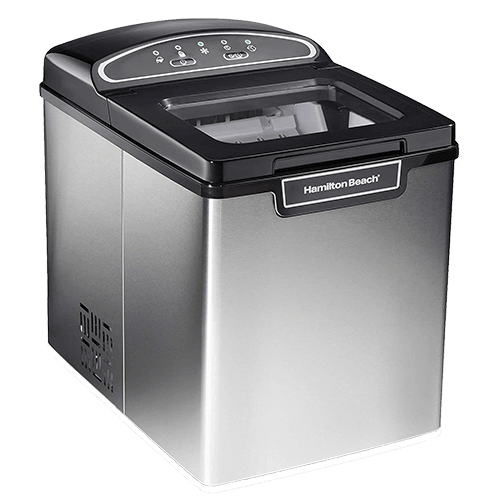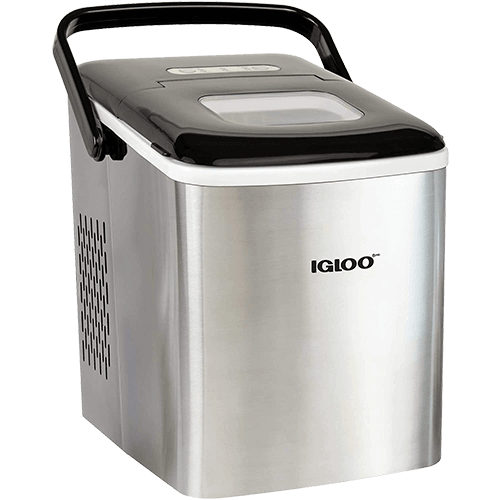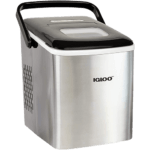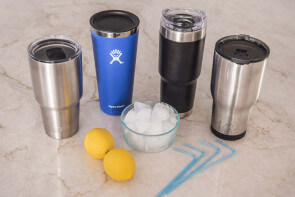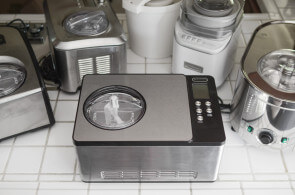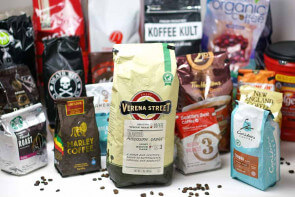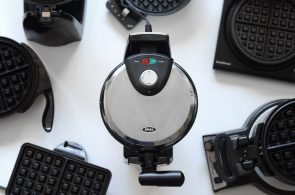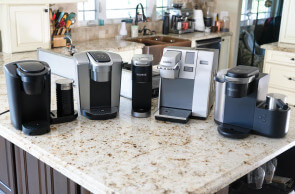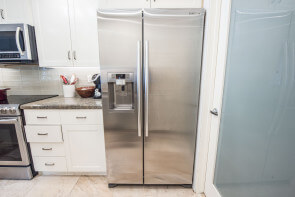
The 8 Best Portable (Countertop) Ice Makers
We spent over 50 hours measuring pounds of ice, including production and melting times, capacity and taste, and selected the Hamilton Beach – 86150 as the best portable ice maker. It’s the quietest of the other ice makers we tested, and it can make 28 pounds of ice in a 24-hour period. Also great, and in close second place, is the Igloo – ICEB26HNSS. It has a sturdy handle so it can be transported anywhere, and a self-cleaning function makes cleaning the Igloo a breeze.
We spent over 50 hours measuring pounds of ice, including production and melting times, capacity and taste, and selected the Hamilton Beach – 86150 as the best portable ice maker. It’s the quietest of the other ice makers we tested, and it can make 28 pounds of ice in a 24-hour period. Also great, and in close second place, is the Igloo – ICEB26HNSS. It has a sturdy handle so it can be transported anywhere, and a self-cleaning function makes cleaning the Igloo a breeze.
Table of contents
- The 8 portable ice makers we tested
- 1. Best overall: Hamilton Beach – 86150
- 2. Also great: Igloo – ICEB26HNSS
- Other products we tested
- How we selected
- How we tested
- Rebranding and knock-off machines
- Important features to consider
- The bottom line
(Editor’s note: We recently learned that our top pick, Della – 048-GM-48186 was discontinued. For this update, we tested the Igloo – ICEB26HNSS to see how it compared to our runner-up, Hamilton Beach – 86150. We were impressed by the Igloo’s performance and convenience, and it is our new runner-up. See our review below.)
The 8 portable ice makers we tested
| Product | Price | Noise Level | Overall Performance |
|---|---|---|---|
| 1. Hamilton Beach - 86150 | $$$ | ☆☆ | ☆☆☆☆☆ |
| 2. Igloo - ICEB26HNSS | $$$ | ☆☆ | ☆☆☆☆ |
| 3. Costway - STAKOL | $$$ | ☆☆☆ | ☆☆☆☆ |
| 4. KUPPET | $$$ | ☆☆☆ | ☆☆☆☆ |
| 5. NewAir - AI-100BK | $$$$ | ☆☆☆ | ☆☆☆ |
| 6. Della - 048-GM-48186 (Discontinued) | $$$ | ☆☆☆ | ☆☆☆☆☆ |
1. Best overall: Hamilton Beach – 86150
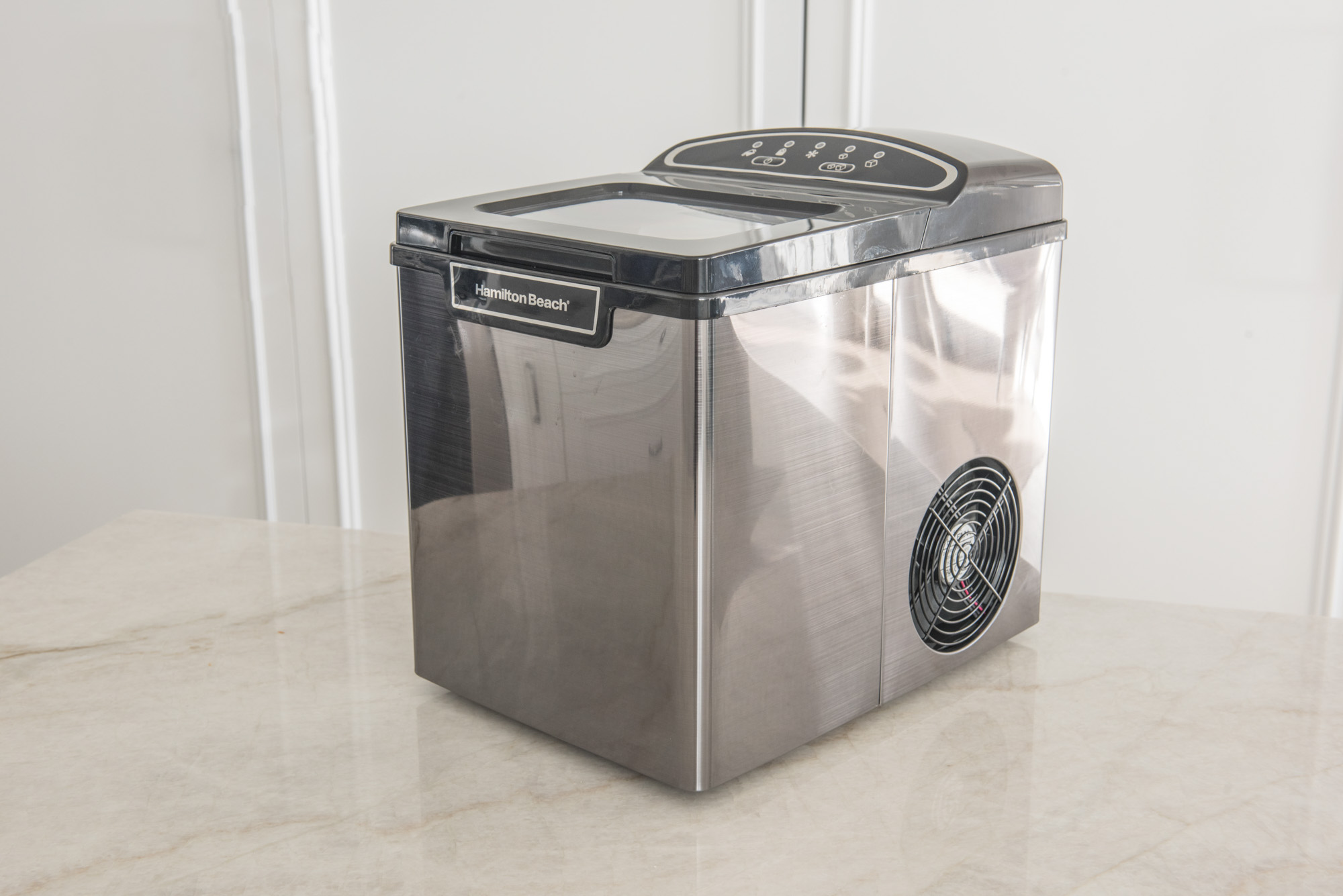
The Hamilton Beach – 86150 can make ice in eight minutes and up to 28 pounds in 24 hours. It has a stainless-steel design with black trim, and its clear, flat lid lets you see the ice forming. It’s also quieter than the others we tested: You hear just a gentle whirring of its fan until the next batch of ice is made. During testing, the Hamilton Beach’s ice made drinks a bit colder — a 22.7°F reduction after the first set of 10 ice cubes, compared to 19°F for the closest competitor.
The Hamilton Beach makes two sizes of hollow, bullet-shaped ice, averaging one pound per hour. We programmed each size separately, but we saw only a small difference between them. The Hamilton Beach is well insulated, so the ice doesn’t melt, and automatically stops when the tray is full (at about 1 pound). Its control panel indicates when you should add water and when you need to empty the removable basket.
When we first reviewed the Hamilton Beach – 86150, it was somewhat more expensive than most of the other ice makers we tested. However, since then, its price has been lowered and is on par with its competitors.
Key Takeaways:
- Hamilton Beach is a reliable ice maker that can make ice in eight minutes.
- It was the quietest model we tested.
- This ice maker has a control panel that indicates when to add water and when to remove the ice.
- Its stainless-steel panels might be a better fit in some kitchens.
Also great: Igloo – ICEB26HNSS

The Igloo – ICEB26HNSS is one of the truly portable ice makers we tested. While other ice makers are a bit cumbersome to lug around, the Igloo has a sturdy handle that makes transport from room-to-room or place-to-place a breeze. Igloo is one of the very few ice makers on the market that has a handle, and if you plan on making ice somewhere other than in the kitchen, this ice maker is an option you should consider.
Although it makes slightly less ice overall (26 pounds in 24 hours) than the competitors, it can churn out ice in a speedy seven minutes. The company touts that the Igloo is silent, but in actuality, it emits a high-pitched humming sound when making ice. The Igloo has good insulation and will keep a batch of ice without melting, so you could actually take this ice maker on a camping trip (where electricity is available of course).
Another nice feature is that the Igloo has a self-cleaning function. You pour in a vinegar-and-water mixture (there are other cleaning solutions available on Amazon), start the clean cycle, and it runs through the ice-making process without the freezing element on. It’s done in about 10 minutes, and then the machine needs to be drained.
Draining the Igloo, however, can be a hassle. The drain plug is located in the bottom right of the unit, so you need to hold that side over the sink. The drain plug is, unfortunately, difficult to remove, and you may need to use pliers or another tool to pop it out.
The Igloo – ICB26HNSS is the stainless-steel version, but there are several other colors available that are differently priced. Other than the tricky drain plug, this Igloo model is another great ice maker you should look into purchasing.
Key takeaways:
- The Igloo – ICEB26HNSS has a sturdy handle that makes it one of the few ice makers that’s truly portable.
- It has a self-cleaning function that runs through an ice-making cycle without the freezing element on.
- Some might find its high-pitched hum annoying.
- The Igloo’s drain plug can be difficult to remove.
Other finalists we tested
Costway – STAKOL

The Costway – STAKOL is yet another ice maker that is nearly identical to the other popular models you’ll find all over the Internet. Costway did a good job with this icemaker on a few counts. It’s quicker at freezing up the very first batch than our runner-up, the Hamilton Beach, by a few minutes. It’s also lighter, which might be more important than overall performance if you’re lugging this to a party.
But, as expected, the differences in actual use between this and most of the other ice makers we tested were so small as to be nearly indistinguishable. After 25 minutes, you’ll have enough ice to cool a glass of water to below 47°F no matter which machine you use. Right now the Costway’s big advantage over other designs is that you can still purchase it: Most of our other top picks went out of stock in 2020, but the Costway is still available.
KUPPET
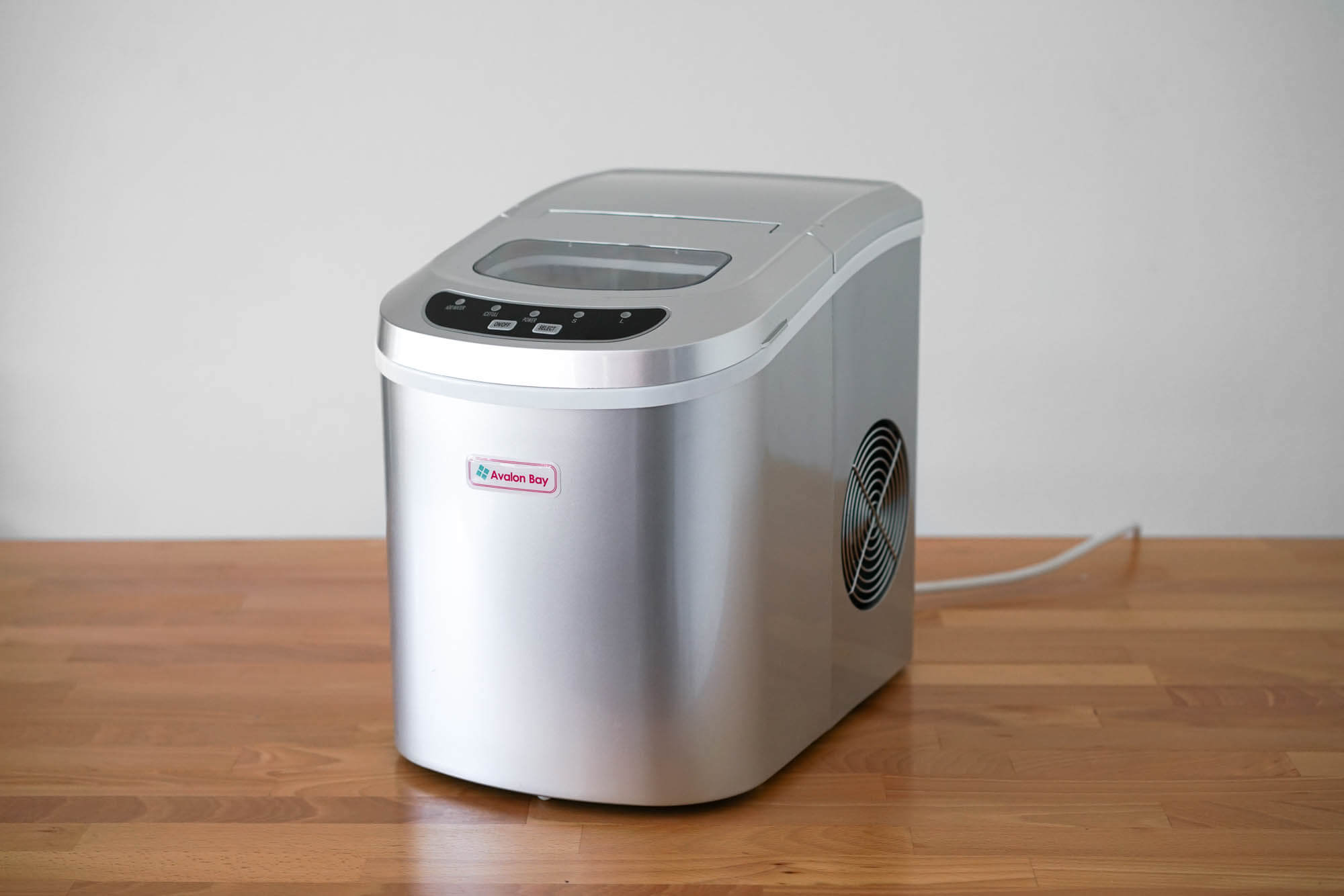
The KUPPET came close to taking our top place in terms of overall ice production rate, with 25.6 pounds per day on its best setting (small ice cubes), and an average of 22.5 pounds per day overall. Like all the ice makers we tested, the KUPPET uses about 100 watts, occasionally spiking at 140 watts, which calculates to a production cost of only two cents per pound. Compared to the cost of a store-bought 10-pound bag of ice, the KUPPET is 20 times less expensive to use.
The KUPPET has a clear display that uses words rather than symbols, and it’s available in three colors. The lid is 1.5 inches thick, which helped keep the ice cold during production. Although the ice tray holds 1.5 pounds of ice, the KUPPET automatically shuts off when 1 pound of ice is made.
NewAir – AI-100BK

The NewAir – AI-100BK is a slightly larger unit and 4 pounds heavier than the KUPPET. Its manufacturer claims that it can produce 18 pounds of ice and has a larger ice tray, storing 2.2 pounds of ice. To our surprise, the NewAir did all that its manufacturer claimed.
However, depending on the size selected, there was considerable variance in how much the ice tray held before the machine automatically shut off: 2.25 pounds for large ice, 2.05 for medium ice, and 1.19 pounds for small ice. That said, the medium size was the most effective setting and produced 26 pounds per day.
Another downside to the NewAir is that it’s difficult to drain. Most portable ice makers drain from the bottom, but the NewAir drains from the side, so we had to tilt the machine to drain out all of the water. The white model that we tested is nearly double the price of the KUPPET; however, the other available colors are about $100 less.
Della 048-GM-48186 (Discontinued)

Until it was discontinued, the Della – 048-GM-48186 had been our top pick because it made the most ice the fastest and with the most consistency. The Della outperformed its competitors on both the large (26 pounds/day) and small (19 pounds/day) settings. Though the KUPPET was a close second, averaging about a third of a pound less per day on both settings, the Della flat out won.
On average, ice production on the small setting yielded almost 7 pounds more per day than the large setting did. In general, the ice sizes differed only a little, but it had more to do with the amount of time the machine had been running rather than the size selected. Overall, the Della was the most effective and affordable portable ice maker with a clean and simple design, easy-to-read programming, and a large clear lid for viewing the ice it’s made.
Ivation (Discontinued)
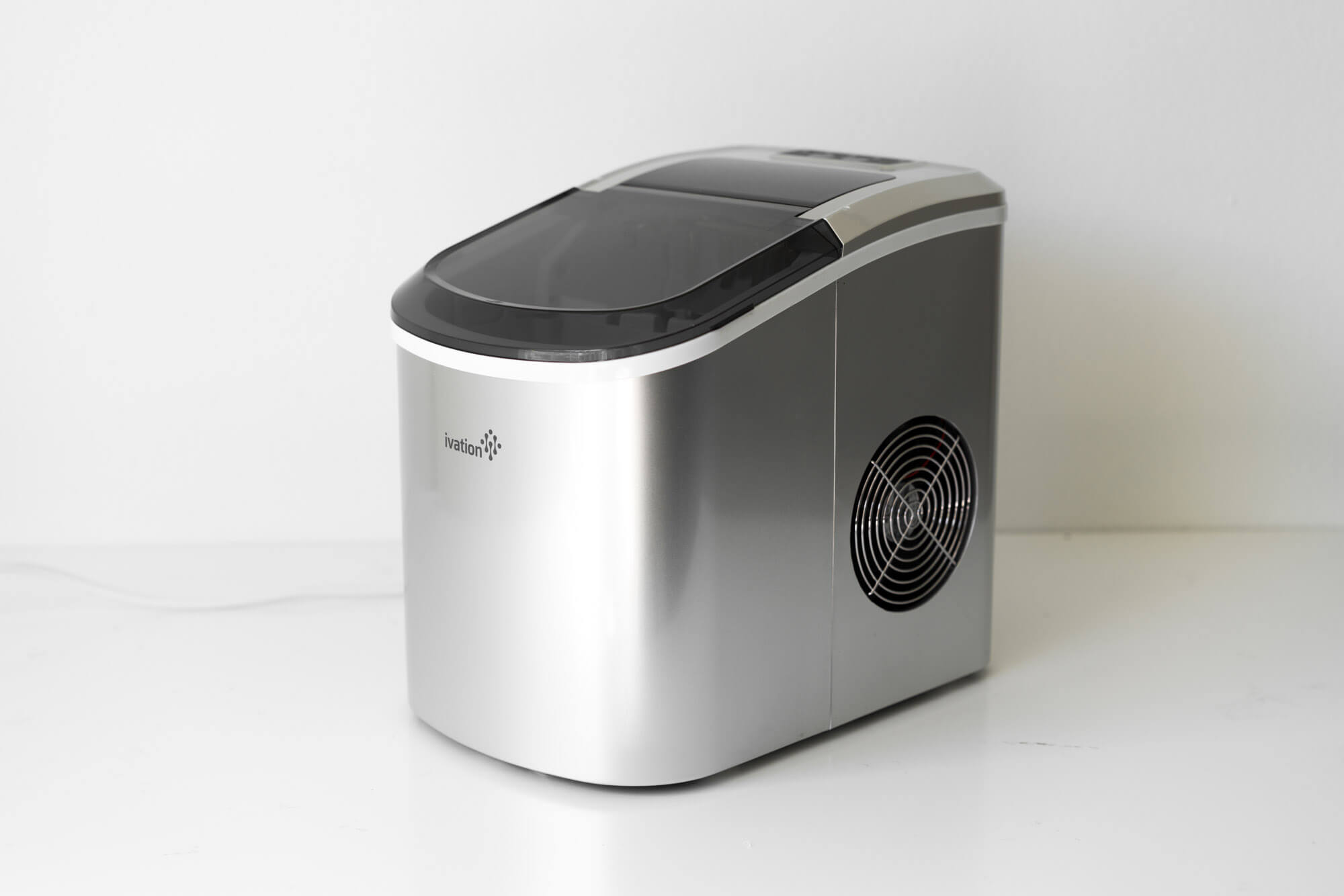
(Editor’s note: The Ivation model that we tested was discontinued. A newer model is on the company’s website, but there is no indication of when it will be released.)
The Ivation went toe-to-toe with Della in ice production and produced 23.5 pounds per day on the small setting. Its thin lid, however, reduced insulation and resulted in one-tenth of a pound melting. That said, the melted ice was simply recycled into the container and made into ice again.
ThinkGizmos (Discontinued)
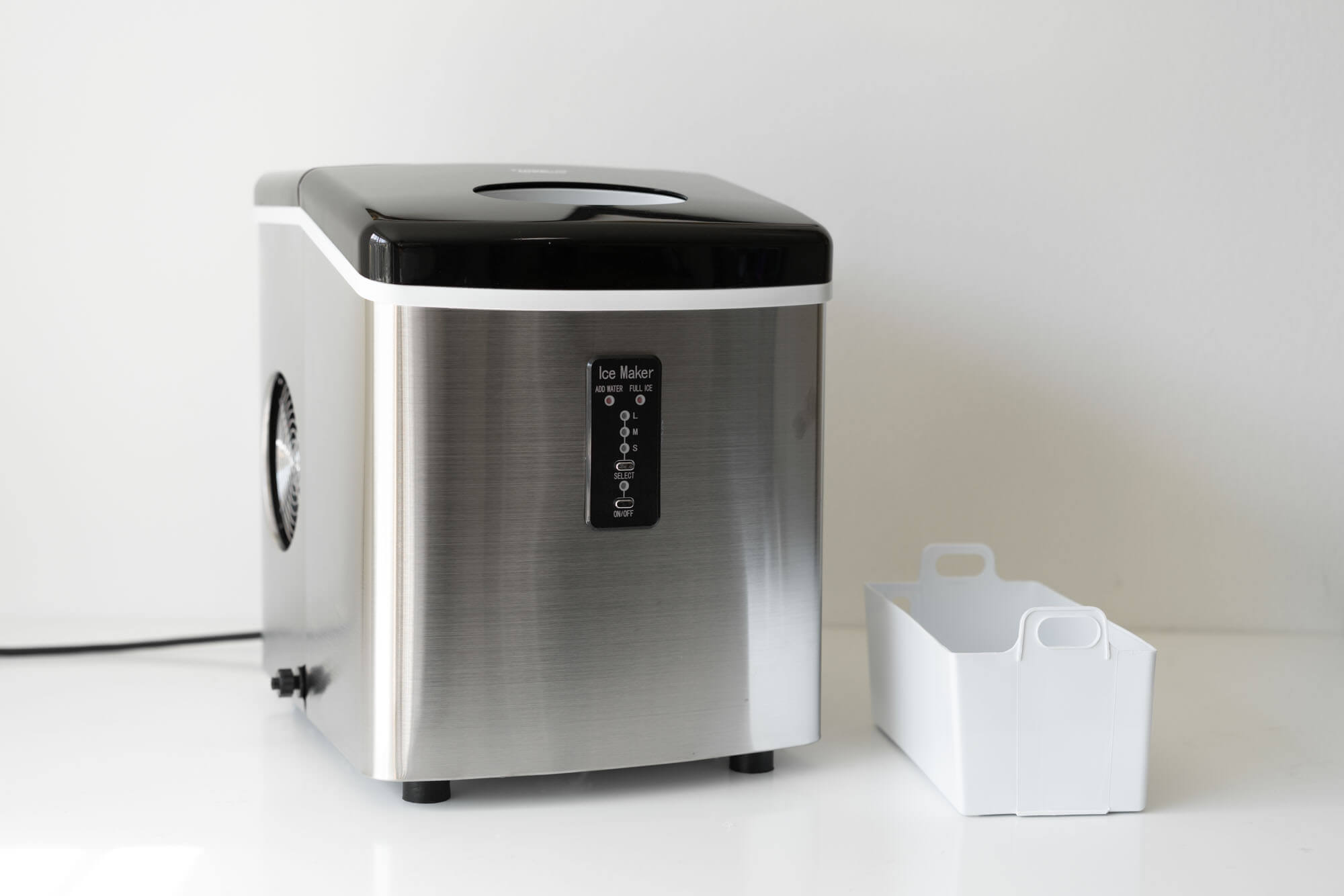
(Editor’s note: ThinkGizmos discontinued this model and no longer sells portable ice makers.)
Despite its high rating on Amazon, ThinkGizmos – TG22 suffered from inconsistency between its settings, both in how much the ice tray could hold and how quickly the ice was produced. Like the units we tested, the ThinkGizmos worked best when making small ice cubes even though it produced the least amount of ice (22.4 pounds per day). At the large setting, the ThinkGizmos performed the worst, producing a meager 11.2 pounds per day.
How we selected
We began our research by familiarizing ourselves with how a portable ice maker works. We watched videos online and then turned to the subreddit /r/Frugal, which provided insight into what consumers are actually looking for in a portable ice maker.
Most other review sites don’t actually conduct real testing of products, so we relied heavily on Amazon reviews to determine which portable ice makers consumers considered to be the best.
Finally, we chose highly rated products that were also different from one another. This actually proved to be quite difficult for such a niche product, the reasons for which we discuss in the section below: “Rebranding and knock-off machines.”
How we tested
Features
| Ice Maker | L x W x H (inches) | Weight (lb) | Watts | Lid Insulation | Maximum Production (lb/day) |
|---|---|---|---|---|---|
| Hamilton Beach - 86150 | 13.5 x 9.75 x 13.0 | 21.0 | 99–106 | Thick | 24.65 |
| Igloo - ICEB26HNSS | 12.2 x 9.06 x 12.8 | 22 | 105 | Thick | 26 |
| Costway - STAKOL | 14 x 9.5 x 13 | 18.2 | 97–150 | Thick | 21.5 |
| KUPPET | 14.8 x 11 x 14.7 | 20.0 | ? | Thick | 25.6 |
| NewAir - AI-100BK | 15.0 x 11.8 x 14.5 | 24.4 | 110–120 | Thick | 26 |
| Della - 048-GM-48186 (Discontinued) | 14.5 x 9.8 x 12.8 | 20.6 | 98–105 | Thick | 26 |
Ice-making ability: The ice makers we tested were supposed to be able to produce 26 pounds of ice per day (28 pounds for the NewAir) We compared the actual production by adding 8 cups of water to each ice maker and timed how long it took to make both large and small ice capsules.
We transferred the ice to a container and weighed it. We then took the total time the machine had been running and calculated the pounds of ice that each machine could produce in 24 hours.
Insulation and temperature: We indirectly measured the insulation of each machine by how well the ice stayed frozen until the tray was full. This was a major variable, as some ice makers had insufficient isolation, and the ice began to melt before the cycle was completed.
Storage: We tested how much water each machine could hold and how much ice it would produce. Generally, the total amount of water exceeded the ice storage capacity.
Size and portability: We measured and weighed each unit to see if it matched the manufacturer’s specs. We also noted how easy or not it was to transport the ice maker from place to place. There actually wasn’t much difference between the units, varying by approximately 5 pounds.
Energy and sound: We checked each manufacturer’s claim of the amount of energy each ice maker actually used and also measured its noise level in decibels.
The ice

We measured how quickly ice was made and how long it took to fill the ice tray. We then made rudimentary calculations to compare the ice to a 10-pound bag from the supermarket.
Melting time: The first melting measurement also took into consideration the size and thickness of the ice and the thickness of the unit’s insulation. We also timed how long one and two batches of ice took to melt in a glass with 12 ounces of water.
Ice size and cooling speed: This test worked in tandem with the melting time as we looked at how much the temperature of the 12-ounce glass of water changed once all of the ice melted.
Taste: This depends largely on the water used (we recommend filtered water). In some reviews, consumers complained that the ice had a “taste.” We found that any off-taste was gone after a first full run and a thorough cleaning of the machine.
Why a portable ice maker?
As every host knows, ice — and plenty of it — is a must-have for any party. Even if you’ve got great beverage containers like those we chose in our insulated tumbler review or insulated water bottle review, ice is essential for keeping any drink as cold as possible. If you’re grilling outside on a hot day, the best lunch boxes and coolers with the best insulation will still need ice to protect uncooked food from entering the bacteria-incubating danger zone.
A portable ice maker makes ice over 20 times faster than a freezer, so you’ll always have it on hand and won’t have to make an ice-run in the middle of a cocktail party. If you buy ice frequently in 10-pound bags at the 7-11, then you’ll be pleased to know that a portable ice maker can make you the same amount for a fraction of the price.
Countertop vs. under-counter models
Countertop portable ice makers
Portable (or countertop) ice makers are about the size of a bread maker. They plug into a standard outlet and require no drainage system or connection to a water line like under-the-counter ice makers. You simply fill them with water, select the size of ice you want, and press start. They can store roughly 1 to 2 pounds at a time, depending on the size of their ice tray and how well the ice maker is insulated.
Portable ice makers are less expensive than under-the-counter ice makers. They’re also quicker at producing ice, and the bullet-shaped pieces of opaque ice they make are smaller and thus melt quicker in your drink.
Under-the-counter ice makers
Under-the-counter ice makers, as the name implies, are installed between kitchen cabinets and need to be hooked up to a water line and a drain. They’re more expensive than portable ice makers, but they have several benefits that portable units don’t have.
First, you won’t need to add water, since it’s added automatically. They also produce double the amount of ice — up to 60 pounds — and the ice stays frozen longer because the under-the-counter ice makers are well insulated. This type of ice maker is ideal for an outdoor bar, an RV or a boat.
Rebranding and knock-off machines

Most portable ice makers are not manufactured by the company that brands them. There is substantial evidence that a Chinese company, Hicon, manufactures the ice makers, and a company slaps its logo on them. This is why you’ll see so many similar — if not identical —
models of portable ice makers that are branded under many different names. Keep this in mind when you’re browsing on Amazon or elsewhere.
Important features to consider
Aesthetic: Although many of the shapes and functions are similar, the overall look of an ice maker is important. The Igloo has several brightly colored models, while the Hamilton Beach has a cleaner, sleeker look that might pair better with other kitchen appliances.
Size: Check the dimensions and weight to make sure it will fit on your countertop or whether it can be easily transported from one location to another.
Ice production: A crucial element in a portable ice maker is how quickly ice is produced. For a cocktail party, figure about one pound per person.
Storage capacity: Storage capacity is another key component. Generally, portable ice makers produce 1.5 to 2 pounds per hour at which point, the ice tray needs to be emptied for another batch of ice can be made.
Price: Cost definitely plays a role. Check out the energy efficiency of each ice maker to see which produces ice at the smallest cost to you (most units make ice at less than two cents per pound).
Noise: Another thing to keep in mind, as with all machines, is how much noise it makes while making ice. Naturally, the quieter the better, and most of the models we tested were at about the same noise level.
How to make ice in a portable ice maker
Making ice in a portable ice maker is a simple process. Once you’ve plugged it in:
- Open the lid, remove the ice tray and fill the tank with filtered water to the “Max” line, about 8-10 cups depending on the model.
- Put the ice tray back in, and close the lid.
- Push the “ON” button, and select the size of ice you’d like. The default is “large,” but we found that to be the slowest for ice production.
Portable ice makers have very few options beyond “on” and off” and size selections. Other LED notifications are “Add water” and “Full ice,” which will light up when it’s time to add water or empty the ice tray.
Similarities between ice makers
- Watts used (energy)
- Decibels created (noise)
- No waterline required
- Nine bullet-shaped ice pieces per batch
- On/Off buttons
- Size settings
- Partially clear top
Differences between ice makers
- Weight, size and color
- Medium size setting on some machines
- Placement of buttons
- Water reservoir size
- Ice tray storage capacity
- Drainage system (side/bottom and plug/screw cap)
How to clean an ice maker

Since these ice makers are designed to be portable and are often used at parties, you may see dust, food crumbs, and grime from the hands of your party guests if they decide to use their hands instead of the scoop. Fortunately, ice makers are easy to clean. The only hitch is if anything sticky gets inside the ice-making section.
After checking instruction manuals for our ice makers and cleaning each of them after testing, here’s our preferred procedure:
- Unplug the ice maker
- Dump out any leftover ice and hold the ice maker over a sink
- Pull the drain plug, usually on the bottom at the front of the ice maker
- Plug the drain
- To de-scale and clean the ice maker, fill the water reservoir with 1/2 cup white vinegar or lemon juice and 5 cups (10:1 ration) of water
- Plug the ice maker back in, and set it to make ice. let it run for at least two cycles (any size)
- Discard the ice and unplug the ice maker
- Drain the cleaning/descaling solution
- Look for any sign of remaining residue or dirt, and if needed scrub with mild dish soap (no abrasives) and a no-scratch kitchen cleaning sponge, or a bottle brush if you need to clean inside the ice-making chamber
- If any dirt, sand, or particles are in the ice maker, wipe them up with a sponge or towel before they can get into the pump
- Rinse with fresh water
- Use a large glass or a faucet hand sprayer to splash rinse water into the ice-making chamber
- Plug the drain and fill the water reservoir completely with clean water
- Plug the ice maker back in. Run at least two batches of ice cubes and discard the ice
- Wash the ice basket and scoop as you would any plastic utensils (dishwasher top rack only)
An ice maker should stay clean for a long time if only water ever goes inside, especially if you use filtered water. (See our reviews of faucet-mount water filters and water filter pitchers for some easy ways to get better-tasting ice.)
The bottom line
If you hate making an ice run in the middle of a party, the Hamilton Beach – 86150 is the best portable ice maker. It’s the quietest of the other ice makers we tested, and it can make 28 pounds of ice in a 24-hour period.
Our runner-up is the Igloo – ICEB26HNSS has a self-cleaning function and is one of the few ice makers on the market that has a handle, so you can make ice in any place that has an electrical outlet.
More Reviews
The Best Pillows for Side Sleepers
Coop Home Goods - Eden
RTIC - 30-Ounce Tumbler
Whynter - ICM-200LS
Verena Street - Mississippi Grogg
Nexus - BD1N
BELLA - 13591 Classic Belgian
The Best Digital Meat Thermometers
Lavatools - Javelin PRO
Keurig - K-Elite
Scrub Daddy
Instant Pot - DUO60
Whirlpool - WRX 735SDHZ


